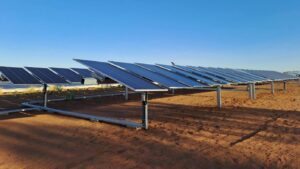PRESS RELEASE
The Flinders Island community can look forward to a secure and cleaner energy future thanks to its new Hybrid Energy Hub.
Officially launched today, the hub will transform the island’s power supply and provide another exceptional renewable showcase for remote communities around Australia and the world.
Flinders Island has historically been dependent on diesel generation. The hub technology will make it 60 per cent renewably-powered, on average, using wind and solar. When there’s enough wind and sunshine to do so, the island will be 100 per cent renewably-powered for considerable periods of time.
The CEO of Hydro Tasmania, Steve Davy, said the result is less diesel usage, lower energy production costs, lower emissions, and a further boost for Flinders’ clean and sustainable reputation.
“This is Tasmanian innovation bringing clean energy to isolated communities,” Mr Davy said.
“The Flinders Island Hybrid Energy Hub gives islanders a secure and cleaner future – consistent with the community’s vision of becoming permanently 100 per cent renewable in the future.
“We take pride in supporting Tasmanian communities and a clean, sustainable energy future – both at a big-picture and grassroots level,” he said.
The Flinders Hub is able to harness more renewable energy from a 900 kilowatt (kW) wind turbine and 200 kW solar array by using unique enabling technologies and an advanced control system that will manage the fluctuating mix of wind, solar and diesel power in a stable, secure and reliable way – as proven in previous projects on King Island, at Coober Pedy, and on Rottnest Island.
The enabling technologies on Flinders include a 750 kilowatt / 266 kilowatt-hour battery, an 850 kilovolt-ampere flywheel, and a 1.5 megawatt dynamic resistor.
The $13.38 million Flinders Island Hybrid Energy Hub project was made possible by support of $5.5 million from the Australian Renewable Energy Agency (ARENA).










